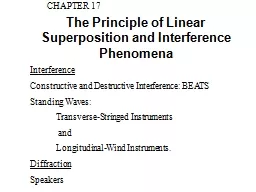

CHAPTER 17 Interference Constructive and Destructive Interference BEATS Standing Waves TransverseStringed Instruments and LongitudinalWind Instruments Diffraction Speakers 176 ID: 636550
Download Presentation The PPT/PDF document "The Principle of Linear Superposition an..." is the property of its rightful owner. Permission is granted to download and print the materials on this web site for personal, non-commercial use only, and to display it on your personal computer provided you do not modify the materials and that you retain all copyright notices contained in the materials. By downloading content from our website, you accept the terms of this agreement.
Slide1
The Principle of Linear Superposition and Interference Phenomena
CHAPTER 17
InterferenceConstructive and Destructive Interference: BEATSStanding Waves: Transverse-Stringed Instruments and Longitudinal-Wind Instruments.Diffraction Speakers
Slide2
17.6 Longitudinal Standing Waves
Musical instruments in the wind family depend on
longitudinal standing waves in producing sound. Since wind instruments (trumpet, flute, clarinet, pipe organ, etc.) are modified tubes or columns of air, it is useful to examine the standing waves that can be set up in such tubes. Slide3
Open tube of air
A pictorial representation of longitudinal standing waves on a Slinky (left side) and in a tube of air (right side) that is open at both ends (A, antinode; N, node).Slide4
Closed tube of air
A pictorial representation of the longitudinal
standing waves on a Slinky (left side) and in a tube of air (right side) that is open only at one end (A, antinode; N, node).Slide5
17.7 Complex Sound Waves
The
sound wave corresponding to a note produced by a musical instrument or a singer is called a complex sound wave. It consists of a mixture of the fundamental and harmonic frequencies. http://phet.colorado.edu/en/simulation/fourierSlide6
Spectrum Analyzer
A microphone detects a complex
sound wave, and a spectrum analyzer determines the amplitude and frequency of each harmonic present in the wave.Slide7
P41: Sound
enters the ear, travels through the auditory canal, and reaches the eardrum. The auditory canal is approximately a tube open at only one end. The other end is closed by the eardrum. A typical length for the auditory canal in an adult is about 2.9 cm. The speed of sound is 343 m/s. What is the fundamental
frequency of the canal? (Interestingly, the fundamental frequency is in the frequency range where human hearing is most sensitive.)
The Sensitivity of the Human Ear